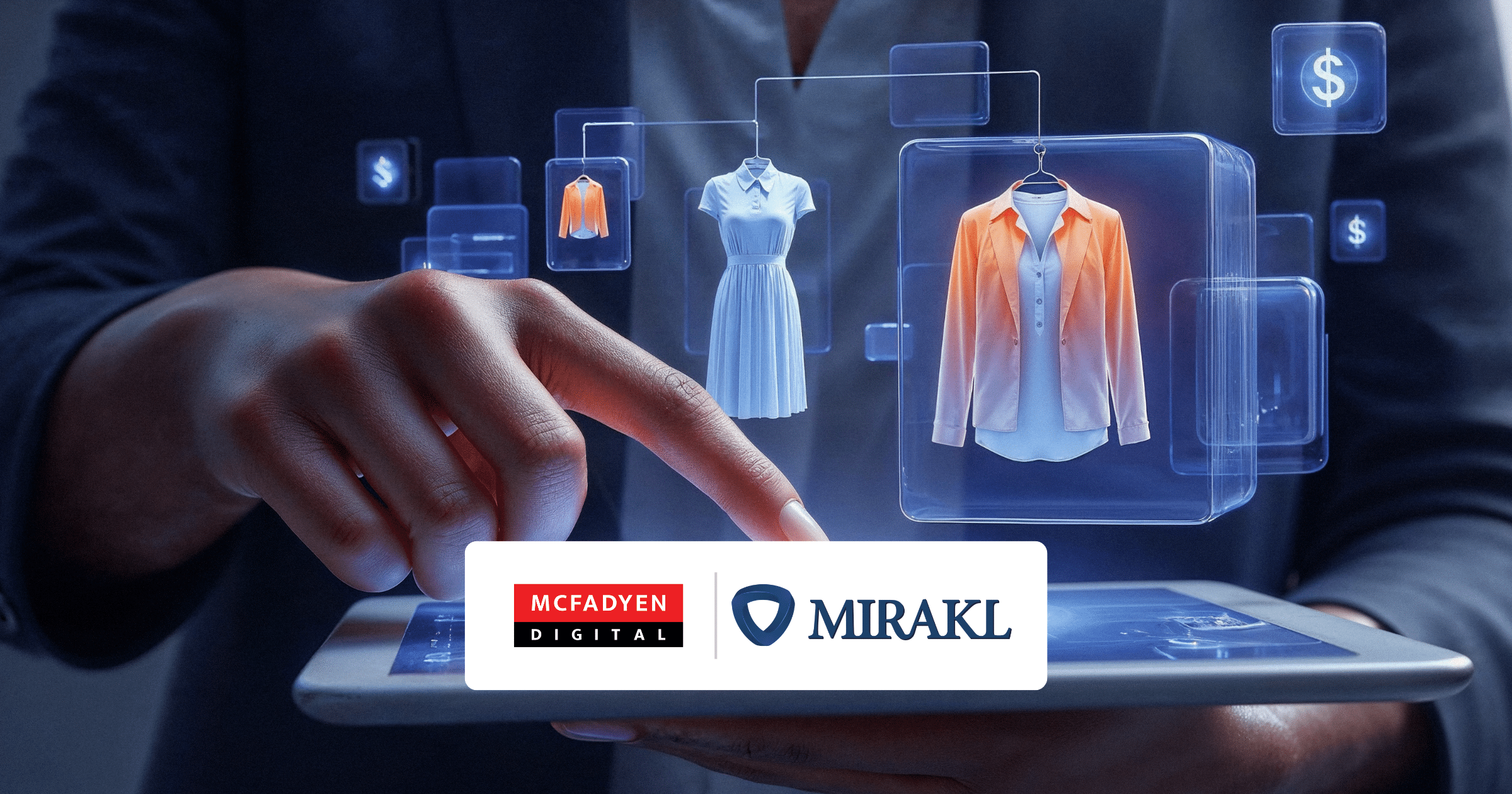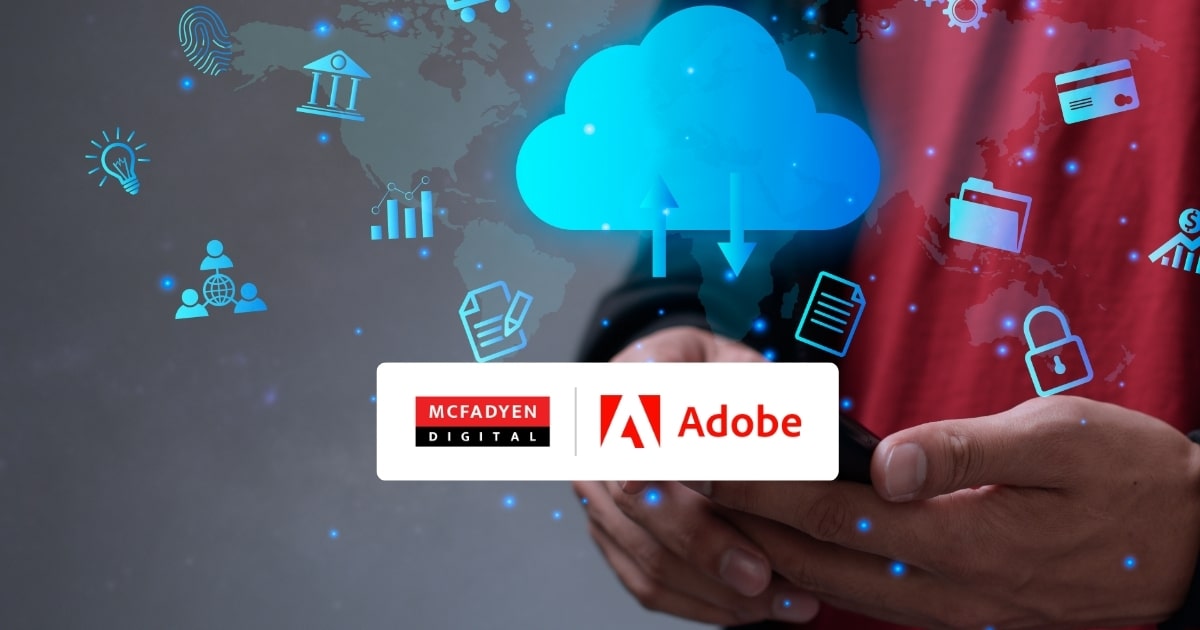
Why SaaS Is Redefining the Commerce Game
In the early days of eCommerce, most organizations were forced into a world of on-premise hosting. Companies owned servers, managed upgrades, and planned every performance improvement and feature rollout themselves. Even as cloud infrastructure grew in popularity, many businesses adopted a Platform-as-a-Service (PaaS) model, which outsourced parts of the infrastructure while still retaining ownership of upgrades and customizations.
Now, Adobe Commerce SaaS changes the equation entirely. By delivering commerce as a managed service, SaaS removes the need for teams to worry about infrastructure, upgrades, and much of the maintenance work that slows down innovation. Instead, it allows companies to focus on what truly matters: delivering better customer experiences and accelerating time-to-value.
This shift is not just about technology. It’s about strategy. Moving to SaaS means rethinking how teams build, launch, and scale digital commerce. The competitive advantage will increasingly come from how quickly a company can test new ideas and iterate on customer experiences—not from how tightly it can control infrastructure.
If your teams are still spending cycles planning platform upgrades, maintaining custom integrations in the core, and coordinating overnights for downtime windows, you’re solving yesterday’s problems. Adobe Commerce SaaS lets you shift the work upstream—toward customer impact, not platform maintenance.
The Real Value of SaaS Beyond the Buzzword
Predictable Costs and Smarter Investments
One of the strongest appeals of SaaS is the financial model. With SaaS, there are no unexpected infrastructure bills or upgrade projects that suddenly pull in dozens of people. Companies know exactly what they will spend each month, and there is a clear path to increasing capacity or features over time without overspending. This predictability allows CFOs to plan budgets with confidence and shifts IT from a cost center to a partner in growth.
Continuous Innovation Without the Pain of Upgrades
In older commerce models, upgrading the platform was a massive project. Teams had to allocate months to test, re-platform, and reconfigure integrations—often just to maintain compatibility or patch security. In SaaS, innovation arrives continuously. New features are deployed, tested, and rolled out in a way that minimizes operational disruption while maximizing the value your teams can deliver. You don’t lose months to upgrades—you gain time back for experimentation and customer experience.
Scalability for Today’s Traffic Surges
Every retailer knows the anxiety of peak traffic moments: Black Friday, Cyber Monday, or flash sales. In on-premise or even PaaS models, you plan for peak and maintain unused capacity most of the year—or you gamble and risk outages. With SaaS, elasticity is built into the operating model. Capacity scales with demand, and you’re not left scrambling or apologizing for a crashed cart. You get the stability of a hardened platform without the overhead of maintaining it yourself.
Security and Compliance as a Service
PCI compliance, GDPR, and data security are constant concerns in commerce. Adobe Commerce SaaS integrates enterprise-grade security, compliance monitoring, and best practices directly into the platform. You’re not on your own to interpret regulations or implement the latest patch—Adobe handles it. This reduces the risk surface and ensures your brand is protected as regulations evolve.
SaaS, PaaS, and On-Premise: What’s Really Different?
Think of the journey as three distinct eras of commerce infrastructure. On-premise represented the early phase, maximum control and maximum responsibility. PaaS provided an intermediate step—outsourcing hosting and some infrastructure while keeping your teams on the hook for customizations, upgrades, and some scaling.
With SaaS, the core is managed for you. Your team focuses on data, experience, and integration—not managing servers or patching vulnerabilities. This distinction becomes critical at scale. With SaaS, the question is no longer “how do we deploy this feature safely?” but “how quickly can we deliver value without breaking the customer experience?”
This difference is not just theoretical. It impacts every department: finance gets predictable budgets, IT reduces overhead and risk, and marketing gains the agility to experiment and deploy without waiting for platform cycles. The result is a more responsive, resilient organization.
Next steps, a practical guide
Enterprise commerce isn’t just moving closer to SaaS; it’s racing toward versionless delivery, edge-rendered storefronts, and an externalized core. Adobe Commerce SaaS (ACCS) and Edge Delivery Services (EDS) change the math by removing upgrade drag and separating “things that make you different” from “things that keep you current.” The decision isn’t whether SaaS is the future—it’s where your estate sits today on complexity and change velocity, and which operating model lets you compound product velocity without breaking the business. The path forward is pragmatic: adopt SaaS where it increases speed-to-value now, externalize complexity into mesh/app builder, and set outcome-based commitments that preserve today’s margins while compounding tomorrow’s agility.
Decision Framework: Stay PaaS or Move to SaaS?
Use this 2×2 to orient the choice. Plot your estate by (a) architectural complexity and (b) business change velocity. Then pick a target operating model that matches the quadrant.
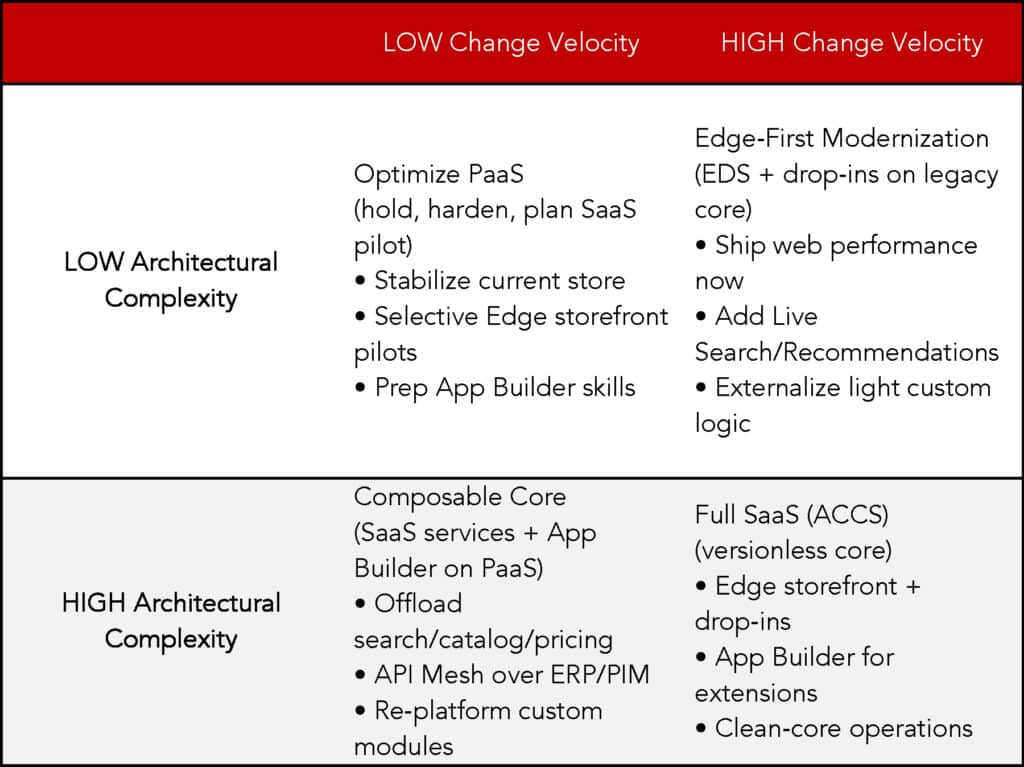
Three Target Operating Models (and How to Choose)
Optimize PaaS (Hold & Harden)
• When: Compliance constraints (e.g., HIPAA today), tight ERP coupling, or low change velocity.
• What: Improve CWV on current stack, rationalize extensions, prepare content ops for
Universal Editor.
• Exit criteria: Clear SaaS blockers removed; App Builder proof of value in place.
Composable Core (Hybrid)
• When: You need speed and scale now, but full cutover would disrupt peak trading windows.
• What: Adopt SaaS services (Live Search, Recommendations, Catalog/Price services), unify via API Mesh, move custom logic to App Builder.
• Exit criteria: ≥80% custom logic externalized; storefront ready for drop‑ins.
Full SaaS (ACCS)
• When: High release cadence, global scale, and desire to eliminate upgrade programs.
• What: Edge storefront + drop‑ins, versionless core, CI/CD aligned to Adobe promotion cadence.
• Exit criteria: Parallel run complete; data migration validated; legacy decommission plan executed.
Where SaaS Creates Immediate Business Impact
Digital Natives and High-Growth Brands
SaaS enables faster iteration with fewer dependencies. Teams can launch new features, run experiments, and improve performance without worrying about underlying version conflicts or platform stresses.
Global Enterprises and Multinational Brands
For enterprises operating across multiple regions, languages, and currencies, SaaS reduces the burden on central IT and allows regional teams to operate more independently. The core remains consistent and secure, while local teams can adapt the experience to market needs.
B2B and Complex Catalog Organizations
SaaS is not just for retail. B2B sellers with complex pricing, contracts, and partner relationships benefit from a managed core that scales without manual tuning. Integrations become more predictable, and the focus shifts to orchestrating data across systems.
Experience-Driven Brands
For brands competing on speed, relevance, and personalization, SaaS shortens the distance between an idea and its impact. Teams can build, test, and deploy new experiences with less fear of breaking the core or introducing instability.
The Broader Business Value of SaaS
SaaS delivers more than technical benefits. It gives organizations the ability to move faster with less risk. It aligns budgets with outcomes, reduces the tax of maintenance, and connects teams around customer impact. It provides a foundation that is both resilient and flexible—ready for the next shift in behavior or market dynamics.
Risk Ledger: What Breaks, What Bends, What Gets Better
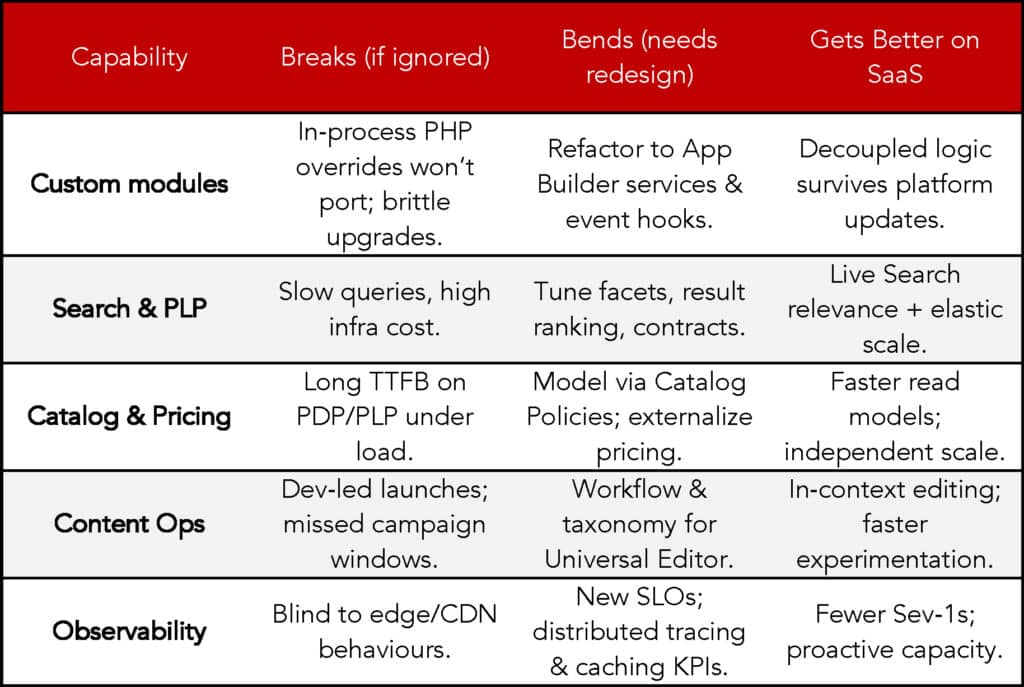
Migration Patterns (and AntiPatterns to Avoid)
Recommended patterns:
• Start with customer‑visible speed: EDS storefront + critical drop‑ins (Cart, Checkout, Search).
• Externalize heavy services early: Live Search, Recommendations, Catalog/Price services.
• Wrap legacy via API Mesh for unified GraphQL; migrate integrations behind the mesh.
• Run a parallel pilot (brand/locale) to validate KPIs before global rollout.
Anti‑patterns:
• Big‑bang catalog remodel + checkout rewrite at once.
• Over‑customizing drop‑ins beyond tokens/slots (forks slow you later).
• Skipping content‑ops enablement for Universal Editor.
• Mesh sprawl without caching strategy and rate‑limit planning.
• Migrating full order history before validating read models & reporting needs.
Timelines & Costs: Scenario Models (Not Just Bands)
Replace generic ranges with drivers you can tune. Use the parametric model below, then apply the scenario cards.
Services Cost ≈ α + β·(# integrations) + γ·(SKUs/100k) + δ·(# brands/locales) + ε·(B2B complexity score)
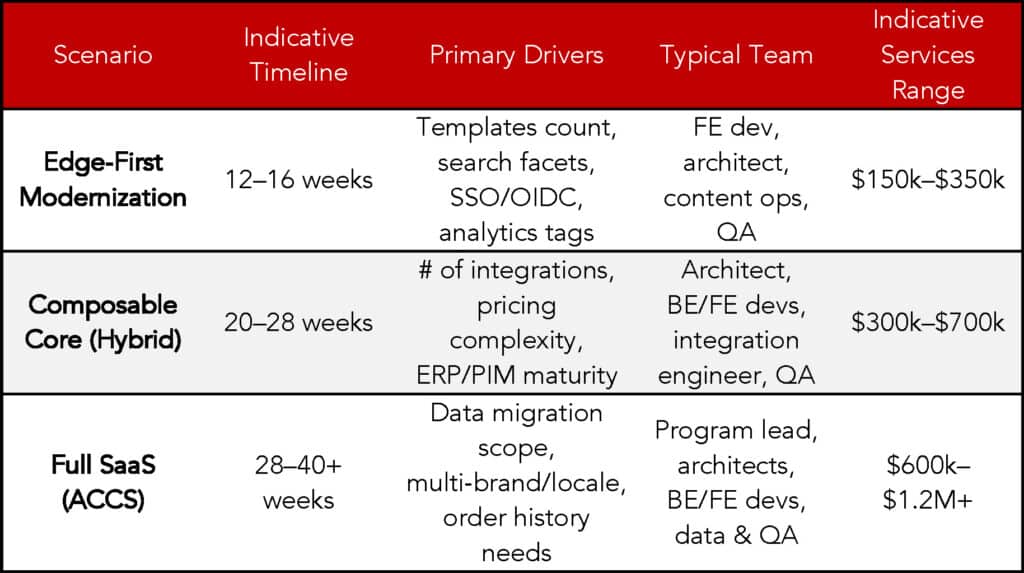
CFO 5‑Year View: Where the ROI Comes From
Outcome‑Based Commitments (What You’ll See, Not Just What We Do)
• Top‑20 PLP/PDP pages achieve LCP < 2.5s by week 8 on EDS.
• ≥95% sandbox hit‑rate prior to ACCS promotion windows.
• ≥80% custom logic externalized to App Builder/API Mesh by cutover.
• Zero‑downtime switchover; < 30‑min data delta sync at cutover.
Challenges in migration from PaaS to SaaS:
- Data Integrity and Security
Challenge: Ensuring data integrity and security during migration.
Solution: Use comprehensive encryption methods for data in transit and at rest. Use secure transfer protocols (e.g., SFTP, HTTPS) and perform rigorous data validation and integrity checks post-migration. - Application Compatibility and Customization
Challenge: Ensuring compatibility of existing customizations and extensions with the SaaS platform.
Solution: Evaluate and prioritize customizations. Use Adobe App Builder for custom logic, and adapt extensions to be loosely coupled and compatible with the SaaS environment. - Managing Downtime and Ensuring Business Continuity
Challenge: Minimizing downtime during migration to avoid business disruption.
Solution: Employ a phased migration approach, including parallel run and blue/green deployments. Validate critical paths and maintain rollback plans to ensure continuity. - Performance and Scalability
Challenge: Ensuring performance and scalability post-migration.
Solution: Leverage Adobe’s Edge Delivery Services for improved performance, and ensure CDN caching strategies are optimized. Monitor and tune performance using built-in tools and observability. - Training and Change Management
Challenge: Ensuring that users are comfortable with the new SaaS platform and can use it effectively.
Solution: Provide training programs, documentation, and hands-on workshops. Establish champions within teams to support adoption. - Cost Management
Challenge: Managing costs associated with the migration and ongoing SaaS usage.
Solution: Develop a clear budget and track ROI by aligning costs with outcomes. Use the parametric model for forecasting services cost and track efficiency gains. - Compliance and Regulatory Requirements
Challenge: Ensuring that the new SaaS environment meets all compliance and regulatory requirements.
Solution: Work closely with legal and compliance teams to align with regulations (e.g., GDPR, PCI). Use Adobe’s compliance certifications and features to meet requirements.
Looking Ahead: The Competitive Edge of SaaS
SaaS is not just a technology choice; it is a business strategy. Companies adopting Adobe Commerce SaaS today are positioned to outpace competitors by reducing the operational drag of maintenance and reallocating resources toward customer value.
With Adobe Commerce SaaS and the right implementation partner, organizations can build a foundation that is resilient, flexible, and ready for whatever the market brings next.
With more than three decades of commerce experience and as an Adobe Gold Partner, McFadyen has a proven track record of successful implementations across industries and business models. We understand the nuances of enterprise commerce and how to leverage the full power of Adobe Commerce SaaS to meet both immediate needs and long-term goals.
Our consultants and engineers specialize in tailoring Adobe Commerce SaaS to match each client’s unique workflows. We help you leverage modular services, connect systems via API Mesh, and build a future-ready architecture that supports ongoing innovation with less risk.
Related Articles
Turn Insight Into Impact.
Start Today.



